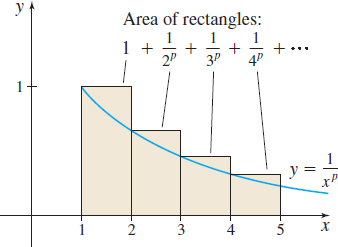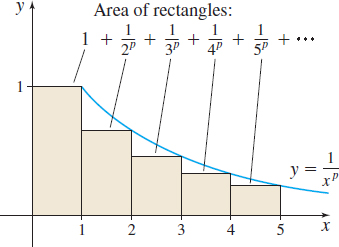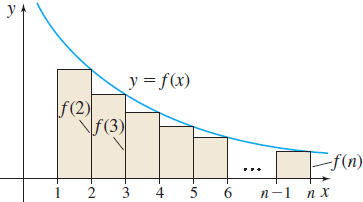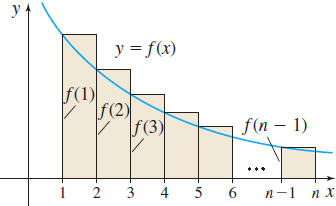8.3 Properties of Series; the Integral TestPrinted Page 566
566
OBJECTIVES
When you finish this section, you should be able to:
We have been determining whether a series ∞∑k=1ak converges or diverges by finding a single compact expression for the sequence {Sn} of partial sums as a function of n, and then examining lim. For most series \sum\limits_{k\,=\,1}^{\infty }a_{k}, however, this is not possible. As a result, we develop alternate methods for determining whether \sum\limits_{k\,=\,1}^{\infty }a_{k} is convergent or divergent. Most of these alternate methods only tell us whether a series converges or diverges, but provide no information about the sum of a convergent series. Fortunately, in many applications involving series, it is more important to know whether or not a series converges. Knowing the sum of a convergent series, although desirable, is not always necessary.
The next result gives a property of convergent series that is used often.
IN WORDS
If \sum\limits_{k\,=\,1}^{\infty }a_{k} converges, then \lim\limits_{n\rightarrow \infty}{ a}_{n} equals 0. If \lim\limits_{n\,\rightarrow\,\infty }{a}_{n} equals 0, then the series \sum\limits_{k\,=\,1}^{\infty }{ a}_{k} may converge or diverge.
THEOREM
If the series \sum\limits_{k\,=\,1}^{\infty }a_{k} converges, then \lim\limits_{n\,\rightarrow \,\infty }a_{n}=0.
Proof
The n{\text{th }} partial sum of \sum\limits_{k\,= \,1}^{\infty }a_{k} is S_{n}=\sum\limits_{k\,=\,1}^{n}a_{k}. Since S_{n-1}=\sum\limits_{k\,=\,1}^{n-1}a_{k}, it follows that a_{n}=S_{n}-S_{n-1}
Since the series \sum\limits_{k\,=\,1}^{\infty }a_{k} converges, the sequence \{S_{n}\} of partial sums has a limit S. Then \lim\limits_{n\, \rightarrow \,\infty }S_{n}=S and \lim\limits_{n\,\rightarrow \,\infty }S_{n-1}=S, so \lim_{n\,\rightarrow \infty }a_{n}=\lim_{n\,\rightarrow \infty }(S_{n}-S_{n-1})=\lim\limits_{n\rightarrow \infty }S_{n}-\lim_{n\rightarrow \infty }S_{n-1}=S-S=0
So if a series \sum\limits_{k\,=\,1}^{\infty }a_{k} converges, then \lim\limits_{n\rightarrow \infty }a_{n}=0. But there are many divergent series \sum\limits_{k\,=\,1}^{\infty }a_{k} for which \lim\limits_{n\, \rightarrow \,\infty }a_{n}=0. For example, the limit of the nth term of the harmonic series \sum\limits_{k\,=\,1}^{\infty }\dfrac{1}{k} is \lim\limits_{n\,\rightarrow \,\infty }\,\dfrac{1}{n}=0, and yet it diverges.
By restating the theorem, we obtain a useful test for divergence.
THEOREM Test for Divergence
The infinite series \sum\limits_{k\,=\,1}^{\infty }a_{k} diverges if \lim\limits_{n\,\rightarrow \,\infty }\,a_{n}\neq 0.
Be careful! In testing \sum\limits_{k=1}^{\infty }a_{k} for convergence/divergence, if \lim\limits_{n\rightarrow \infty }a_{n}\neq 0, the series diverges, but if \lim\limits_{n\rightarrow \infty }a_{n}=0, the series may converge or it may diverge.
1 Use the Test for DivergencePrinted Page 567
567
EXAMPLE 1Using the Test for Divergence
- (a) \sum\limits_{k\,=\,1}^{\infty }87 diverges, since \lim\limits_{n\,\rightarrow \,\infty }87=87\neq 0.
- (b) \sum\limits_{k\,=\,1}^{\infty }k diverges, since \lim\limits_{n\,\rightarrow \,\infty }n=\infty \neq 0.
- (c) \sum\limits_{k\,=\,1}^{\infty }(-1)^{k} diverges, since \lim\limits_{n\,\rightarrow \,\infty }\,(-1)^{n} does not exist.
- (d) \sum\limits_{k\,=\,1}^{\infty }2^{k} diverges, since \lim\limits_{n\,\rightarrow \,\infty }\,2^{n}=\infty \neq 0.
NOW WORK
2 Work with Properties of SeriesPrinted Page 567
Next we investigate some properties of convergent and divergent series. Knowing these properties can help to determine whether a series converges or diverges.
THEOREM
If two infinite series are identical after a certain term, then either both series converge or both series diverge. If both series converge, they do not necessarily have the same sum.
Proof
Consider the two series \begin{eqnarray*} \sum_{k\,=\,1}^{\infty }a_{k} &=& a_{1}+a_{2}+\cdots +a_{p}+a_{p+1}+\cdots +a_{n}+\cdots \\[5pt] \sum_{k\,=\,1}^{\infty }b_{k} &=& b_{1}+b_{2}+\cdots +b_{p}+a_{p+1}+\cdots +a_{n}+\cdots \end{eqnarray*}
Notice that after the first p terms, the remaining terms of both series are identical. The sequence \{S_{n}\} of partial sums of \sum\limits_{k\,=\,1}^{\infty }a_{k} and the sequence \{T_{n}\} of partial sums of \sum\limits_{k\,=\,1}^{\infty }b_{k} are given by \begin{eqnarray*} S_{n}& =a_{1}+a_{2}+\cdots +a_{p}+a_{p+1}+\cdots +a_{n} \\[5pt] T_{n}& =b_{1}+b_{2}+\cdots +b_{p}+a_{p+1}+\cdots +a_{n} \end{eqnarray*}
Now, \begin{eqnarray*} \begin{array}{@{}rl@{}l} S_{n}-T_{n} &= \left({a_{1}+\cdots +a_{p}}\right) -(b_{1}+\cdots +b_{p}) & {\color{#00ADEE}{{\hbox{ After the }}}{\color{#00ADEE}{p\hbox{th}}} {\color{#00ADEE}{\hbox{ term, the}}}} \\[-1.5pt] && {\color{#00ADEE}{{\hbox{ terms are the same.}}}}\\[4.5pt] S_{n} &= T_{n}+\left({a_{1}+\cdots +a_{p}}\right) -(b_{1}+\cdots +b_{p}) & {\color{#00ADEE}{{\hbox{ For } n>p.}}} \\[7pt] \lim\limits_{n\,\rightarrow \,\infty }S_{n}&= \lim\limits_{n\,\rightarrow \,\infty } \, \, \left[ T_{n}+(a_{1}+\cdots +a_{p})-(b_{1}+\cdots +b_{p})\right]\\[11pt] \lim\limits_{n\,\rightarrow \,\infty }S_{n} &= \lim\limits_{n\,\rightarrow \,\infty }T_{n}+\lim\limits_{n\,\rightarrow \,\infty }\,\,\left[ (a_{1}+\cdots + a_{p})-(b_{1}+\cdots +b_{p})\right] \\[11pt] \lim\limits_{n\,\rightarrow \,\infty }S_{n} &= \lim\limits_{n\,\rightarrow \,\infty }T_{n}+k & {\color{#00ADEE}{{\hbox{\(k=(a_1+ \cdots +a_p)\)}}}}\\[-5pt] &&{\color{#00ADEE}{{\hbox{\(-(b_1 + \cdots +b_p)\)}}}}\\[-1.5pt] &&{\color{#00ADEE}{{\hbox{is some number.}}}} \end{array} \end{eqnarray*}
Consequently, either both limits exist (both series converge) or neither limit exists (both series diverge). No other possibility can occur.
568
THEOREM Sum and Difference of Convergent Series
If \sum\limits_{k\,=\,1}^{\infty }a_{k}=S and \sum\limits_{k\,=\,1}^{\infty }b_{k}=T are two convergent series, then the series \sum\limits_{k\,=\,1}^{\infty }\,(a_{k}+\,b_{k}) and the series \sum\limits_{k\,=\,1}^{\infty }(a_{k}-\,b_{k}) also converge. Moreover, \bbox[5px, border:1px solid black, #F9F7ED]{\bbox[#FAF8ED,5pt]{ \sum\limits_{k\,=\,1}^{\infty }(a_{k} + b_{k})=\sum\limits_{k\,=\,1}^{\infty }a_{k} + \sum\limits_{k\,=\,1}^{\infty }b_{k}=S + T }} \bbox[5px, border:1px solid black, #F9F7ED]{\bbox[#FAF8ED,5pt]{ \sum\limits_{k\,=\,1}^{\infty }(a_{k} - b_{k})=\sum\limits_{k\,=\,1}^{\infty }a_{k} - \sum\limits_{k\,=\,1}^{\infty }b_{k}=S - T }}
The proof of the sum part of this theorem is left as an exercise. See Problem 65.
THEOREM Constant Multiple of a Series
Let c be a nonzero real number. If \sum\limits_{k\,=\,1}^{\infty }a_{k}=S is a convergent series, then the series \sum\limits_{k\,=\,1}^{\infty }(ca_{k}) also converges. Moreover, \bbox[5px, border:1px solid black, #F9F7ED]{\bbox[#FAF8ED,5pt]{ \sum\limits_{k\,=\,1}^{\infty }(ca_{k})=c\sum\limits_{k\,=\,1}^{\infty}a_{k}=cS }}
If the series \sum\limits_{k\,=\,1}^{\infty }a_{k} diverges, then the series \sum\limits_{k\,=\,1}^{\infty} (ca_{k}) also diverges.
The proof of the convergent part of this theorem is left as an exercise. See Problem 66.
IN WORDS
Multiplying each term of a series by a nonzero constant does not affect the convergence (or divergence) of the series.
EXAMPLE 2Using Properties of Series
Determine whether each series converges or diverges. If it converges, find its sum.
- (a) \sum\limits_{k\,=\,4}^{\infty }\dfrac{1}{k}
- (b) \sum\limits_{k\,=\,1}^{\infty}\dfrac{2}{k}
- (c) \sum\limits_{k\,=\,1}^{\infty }\,\left( \dfrac{1}{2^{k-1}}+\dfrac{1}{3^{k-1}}\right)
Solution (a) Except for the first three terms, the series \sum\limits_{k\,=\,4}^{\infty }\dfrac{1}{k}=\dfrac{1}{4}+\dfrac{1}{5}+\dfrac{ 1}{6}+\cdots is identical to the harmonic series, which diverges. So, it follows that \sum\limits_{k\,=\,4}^{\infty }\dfrac{1}{k} also diverges.
(b) \sum\limits_{k\,=\,1}^{\infty }\dfrac{2}{k}\,{=}\,\sum\limits_{k\,=\,1}^{\infty }\,\left(2\cdot \dfrac{1}{k}\right). Since the harmonic series \sum\limits_{k\,=\,1}^{\infty }\dfrac{1}{k} diverges, the series \sum\limits_{k\,=\,1}^{\infty }\,\left( 2\cdot \dfrac{1}{k}\right)=\sum\limits_{k\,=\,1}^{\infty }\dfrac{2}{k} diverges.
(c) Since the series \sum\limits_{k\,=\,1}^{\infty }\dfrac{1}{ 2^{k-1}} and the series \sum\limits_{k\,=\,1}^{\infty }\dfrac{1}{3^{k-1}} are both convergent geometric series, the series defined by \sum\limits_{k\,=\,1}^{\infty }\,\left( \dfrac{1}{2^{k-1}}+\dfrac{1}{3^{k-1}} \right) is also convergent. The sum is \sum\limits_{k\,=\,1}^{\infty }\,\left( \dfrac{1}{2^{k-1}}+\dfrac{1}{3^{k-1}} \right) =\sum\limits_{k\,=\,1}^{\infty }\dfrac{1}{2^{k-1}} +\sum\limits_{k\,=\,1}^{\infty }\dfrac{1}{3^{k-1}}=\frac{1}{1-\dfrac{1}{2}}+ \frac{1}{1-\dfrac{1}{3}}=2+\frac{3}{2}=\dfrac{7}{2}
NOW WORK
569
For series that have only positive terms, it is possible to construct tests for convergence that use only the nth term of the series and do not require knowledge of the form of the sequence \{S_{n}\} of partial sums.
For example, consider an infinite series \sum\limits_{k\,=\,1}^{\infty }a_{k}=a_{1}+a_{2}+\cdots +a_{n}+\cdots
where each term is positive. Suppose \{S_{n}\} is the sequence of partial sums. Since each term a_{n}\,{>}\,0, then S_{n}=S_{n-1}+a_{n}\,{>}\,S_{n-1}. That is, the sequence \{{ S}_{n}\} of partial sums is increasing. If \{S_{n}\} is bounded from above, then the sequence \{S_{n}\} of partial sums converges (p. 549, Section 8.1). The General Convergence Test follows from this conclusion.
THEOREM General Convergence Test
An infinite series of positive terms converges if and only if its sequence of partial sums is bounded. The sum of such an infinite series will not exceed an upper bound.
We use this theorem to develop other tests for convergence of positive series; the first one we discuss is the Integral Test.
NEED TO REVIEW?
Improper Integrals are discussed in Section 7.8, pp. 523-29.
THEOREM Integral Test
Let f be a function that is continuous, positive, and decreasing on the interval [1,\infty). Let a_{k}=f(k) for all positive integers k. Then the series \sum\limits_{k\,=\,1}^{\infty }a_{k} converges if and only if the improper integral \int_{1}^{\infty}f(x)\,dx converges.
A proof of the Integral Test is given at the end of the section.
3 Use the Integral TestPrinted Page 569
The Integral Test is used when the nth term of the series is related to a function f that not only is continuous, positive, and decreasing on the interval [1,\,\infty) , but also has an antiderivative that can be readily found.
EXAMPLE 3Using the Integral Test
Determine whether the series \sum\limits_{k\,=\,1}^{\infty }a_{k}= \sum\limits_{k\,=\,1}^{\infty}\dfrac{4}{k^{2}+1} converges or diverges.
Solution The function f(x)=\dfrac{4}{x^{2}+1} is defined on the interval [1,\infty) and is continuous, positive, and decreasing for all numbers x\geq 1. Also, a_{k}=f(k) for all positive integers k. Using the Integral Test, we find \begin{eqnarray*} \int_{1}^{\infty }\!\dfrac{4}{x^{2}+1}\,dx\! : \lim_{b\,\rightarrow \,\infty }\int_{1}^{b}\dfrac{4}{x^{2}+1}\,dx&=&\lim_{b\,\rightarrow \,\infty } \,\left[ 4\int_{1}^{b}\dfrac{1}{x^{2}+1}\,dx\right] =4\lim_{b\,\rightarrow \,\infty }\,\left[\tan ^{-1}x\right] _{1}^{b} \\[12pt] &=& 4\lim_{b\,\rightarrow \,\infty }\,\left[\tan ^{-1}b-\tan ^{-1}1\right]\! =4\,\left[\dfrac{\pi }{2}-\dfrac{\pi }{4}\right]\! =\pi \end{eqnarray*}
Since the improper integral converges, the series \sum\limits_{k\,=\,1}^{\infty}\dfrac{4}{k^{2}+1} converges.
CAUTION
In Example 3 the fact that \int_{1}^{\infty }\dfrac{4}{ x^{2}+1}\,dx= \pi does not mean that the sum S of the series is \pi . Do not confuse the value of the improper integral \int_{1}^{\infty }f(x) \,dx with the sum S of the series. In general, they are not equal.
570
EXAMPLE 4Using the Integral Test
Determine whether the series \sum\limits_{k\,=\,1}^{\infty }a_{k}= \sum\limits_{k=1}^{\infty }\dfrac{2k}{k^{2}+1} converges or diverges.
Solution The function f(x)=\dfrac{2x}{x^{2}+1} is continuous, positive, and decreasing since f' (x) \le 0 for all numbers x\,{\geq}\,1, and a_{k}\,{=}\,f(k) for all positive integers k. Using the Integral Test, we find \begin{eqnarray*} \int_{1}^{\infty }\frac{2x}{x^{2}+1}\,dx\! : \lim_{b\,\rightarrow \,\infty }\int_{1}^{b}\frac{2x}{x^{2}+1}\,dx&=&\lim_{b\,\rightarrow \,\infty }\,\left[\ln (x^{2}+1)\right] _{1}^{b} \\[8pt] &=& \lim_{b\,\rightarrow \,\infty }\,[\ln(b^{2}+1)-\ln 2] =\infty \end{eqnarray*}
Since the improper integral diverges, the series \sum\limits_{k=1}^{\infty}\dfrac{2k}{k^{2}+1} also diverges.
NOW WORK
To use the Integral Test, the lower limit of integration does not need to be 1, as we see in the next example.
EXAMPLE 5Using the Integral Test
Determine whether the series \sum\limits_{k\,=2}^{\infty }\dfrac{1}{k(\ln k) ^{2}} converges or diverges.
Solution The function f(x)\,{=}\,\dfrac{1}{x (\ln x)^{2}} is continuous, positive, and decreasing on the interval [2,\infty). Also \dfrac{1}{k(\ln k) ^{2}}\,{=}\,f(k) for all integers greater than or equal to 2. Using the Integral Test, we investigate the improper integral \int_{2}^{\infty }\dfrac{dx}{x(\ln x)^{2} }. We find an antiderivative of \dfrac{1}{x(\ln x) ^{2}} by using the substitution u=\ln x, du=\dfrac{1}{x}dx. Then, \int \frac{dx}{x(\ln x)^{2}}=\int \frac{du}{u^{2}}=-\frac{1}{u}+C=-\frac{1 }{\ln x}+C
Now we find the improper integral \int_{2}^{\infty }\frac{dx}{x(\ln x)^{2}}\!:\,\,\lim_{b\,\rightarrow \,\infty }\,\left[ -\frac{1}{\ln x} \right] _{2}^{b}=\lim_{b\, \rightarrow \,\infty }\,\left( -\frac{1}{\ln b}\right) +\frac{1}{\ln 2}=\frac{1 }{\ln 2}
Since the improper integral \int_{2}^{\infty }\dfrac{dx}{x(\ln x)^{2}} converges, the series \sum\limits_{k\,=2}^{\infty }\dfrac{1}{k(\ln k) ^{2}} converges.
NOW WORK
4 Analyze a p-Series
Printed Page 570
Another important series is the p-series.
DEFINITION p-series
A p-series is an infinite series of the form \bbox[5px, border:1px solid black, #F9F7ED]{\bbox[#FAF8ED,5pt]{ \sum\limits_{k=1}^{\infty }\dfrac{1}{k^{p}}=1+\dfrac{1}{2^{p}}+\dfrac{1}{3^{p}}+\cdots +\dfrac{1}{n^{p}}+\cdots }}
where p is a positive real number.
571
A p-series is sometimes referred to as a hyperharmonic series, since the harmonic series is a special case of a p-series when p=1. Some examples of p-series are \begin{array}{rl@{\quad}ll@{\quad}l} p &=1: & \sum\limits_{k\,=\,1}^{\infty }\dfrac{1}{k} &= 1+\dfrac{1}{2}+\dfrac{1}{3}+\cdots +\dfrac{1}{n}+\cdots & {\color{#00ADEE}{{\hbox{The harmonic series}}}} \\ p &=\dfrac{1}{2}: & \sum\limits_{k\,=\,1}^{\infty}\dfrac{1}{k^{1/2}} &= 1+\dfrac{1}{2^{1/2}}+\dfrac{1}{3^{1/2}}+\cdots +\dfrac{1}{n^{1/2}}+\cdots\\ p &=3: & \sum\limits_{k\,=\,1}^{\infty }\dfrac{1}{k^{3}} & =1+\dfrac{1}{2^{3}}+\dfrac{1}{3^{3}}+\cdots +\dfrac{1}{n^{3}}+\cdots \end{array}
The following theorem establishes the values of p for which a p-series converges and for which it diverges.
THEOREM Convergence/Divergence of a p-Series
The p-series \sum_{k=1}^{\infty }\frac{1}{k^{p}}=1+\frac{1}{2^{p}}+\frac{1}{3^{p}}+\cdots +\frac{1}{n^{p}}+\cdots
converges if p>1 and diverges if 0<p\leq 1.
Proof
The function f(x)=\dfrac{1}{x^{p}}, p>0, is continuous, positive, and decreasing for all numbers x\geq 1, and f(k) =\dfrac{1}{k^{p}} for all positive integers k. So, the series \sum\limits_{k\,=\,1}^{\infty }\dfrac{1}{k^{p}} converges if and only if the improper integral \int_{1}^{\,\infty }\dfrac{1}{x^{p}}\,dx converges.
In Section 7.8, page 526, we proved that \int_{1}^{\,\infty }\dfrac{ dx}{x^{p}} converges if p>1 and diverges if p\leq 1. So, the p-series \sum\limits_{k\,=\,1}^{\infty }\dfrac{1}{k^{p}} converges if p>1 and diverges if 0<p\leq 1.
EXAMPLE 6Analyzing a p-Series
- (a) The series \sum_{k\,=\,1}^{\infty }\frac{1}{k^{3}}=1+\frac{1}{2^{3}}+\frac{1}{3^{3}} +\cdots +\frac{1}{n^{3}}+\cdots converges, since it is a p-series where p=3.
- (b) The series \sum_{k\,=\,1}^{\infty }\frac{1}{\sqrt{k}}=1+\frac{1}{\sqrt{2}}+\frac{1}{ \sqrt{3}}+\cdots +\frac{1}{\sqrt{n}}+\cdots diverges, since it is a p-series where p=\dfrac{1}{2}.
NOW WORK
The theorem describing the criterion for the convergence or divergence of a p-series has an interesting corollary that establishes a pair of bounds for the sum of a convergent p-series.
572
IN WORDS
The corollary provides an interval of width 1 that contains the sum of a convergent p-series. But it gives no information about the actual sum.
COROLLARY Bounds for the Sum of a Convergent p-Series
If p>1, then \bbox[5px, border:1px solid black, #F9F7ED]{\bbox[#FAF8ED,5pt]{ \dfrac{1}{p-1}<\sum\limits_{k\,=\,1}^{\infty }\dfrac{1}{k^{p}}<1+\dfrac{1}{p-1}} }
Proof
From Figure 19 we have \begin{equation*} \left(\hbox{Area under the graph of } y=\frac{1}{x^{p}}\right) =\int_{1}^{\,\infty }\frac{dx}{x^{p}}< 1 + \frac{1}{2^{p}} + \frac{1}{3^{p}} + \cdots =\sum\limits_{k\,=\,1}^{\infty }\frac{1}{k^{p}} \tag{1} \end{equation*}
From Figure 20 we have \begin{equation*} \hbox{1} + \left(\hbox{Area under the graph of}\, y = \frac{1}{x^{p}}\right) = 1 + \int_{1}^{\,\infty }\frac{dx}{x^{p}}> 1 + \frac{1}{2^{p}} + \frac{1}{3^{p}} + \cdots = \sum\limits_{k\,=\,1}^{\infty }\frac{1}{k^{p}} \tag{2} \end{equation*}
Combining (1) and (2), we have \begin{equation*} \int_{1}^{\,\infty }\frac{dx}{x^{p}} < \sum\limits_{k\,=\,1}^{\infty }\frac{1}{k^{p}} < 1 + \int_{1}^{\,\infty }\frac{dx}{x^{p}} \tag{3} \end{equation*}
Since p>1, \begin{eqnarray*} \int_{1}^{\,\infty }\frac{dx}{x^{p}}=\lim_{b\,\rightarrow \,\infty }\int_{1}^{b}\frac{dx}{x^{p}}=\lim_{b\,\rightarrow \,\infty } \,\bigg[\frac{x^{-p+1}}{-p+1}\bigg]^{b}_{1} = \lim_{b\,\rightarrow \,\infty } \frac{b^{1-p}-1}{1-p} \underset{\underset{\color{#0066A7}{\hbox{\(p\, > \,1\)}}}{\color{#0066A7}{\uparrow}}}{=} \frac{0-1}{1-p} = \frac{1}{p-1} \end{eqnarray*}
Using this result in (3), we get \frac{1}{p-1}<\sum_{k\,=\,1}^{\infty }\frac{1}{k^{p}}<1+\frac{1}{p-1}
For example, based on the corollary, if p=2, then 1<\sum\limits_{k\,= \,1}^{\infty }\dfrac{1}{k^{2}}<2, and if p=3, then \dfrac{1}{2} <\sum\limits_{k\,=\,1}^{\infty }\dfrac{1}{k^{3}}<\dfrac{3}{2}.
Since \sum\limits_{k\,=\,1}^{\infty }\dfrac{1}{k^{p}} converges for p>1, the series has a sum S. However, the exact sum has been found only for positive even integers p. In 1752 Euler was the first to show that \sum\limits_{k\,=\,1}^{\infty }\dfrac{1}{k^{2}}=\dfrac{\pi ^{2}}{6}. But the sum of other convergent p-series, such as \sum\limits_{k\,=\,1}^{ \infty }\dfrac{1}{k^{3}}, is not known.
Proof of the Integral Test
Suppose \int_{1}^{\infty}f(x)\,dx converges. Then \lim\limits_{n\,\rightarrow \,\infty }\int_{1}^{n}f(x)\,dx exists and equals some number L. As Figure 21 shows, \int_{1}^{n}f(x)\,dx underestimates the area under the graph of f on [1,\infty). As a result, \int_{1}^{n}\,f(x)dx<L \qquad \hbox{for any number }n
But f is decreasing on the interval [1,n]. So, the sum of the areas of the n-1 rectangles drawn in Figure 21 underestimates the area under the graph of y=f(x) from 1 to n. That is, f(2)+f(3)+\cdots +f(n)<\int_{1}^{n}f(x)\,dx <L
Now add f(1)=a_{1} to each part, and use the fact that a_{1}=f(1), a_{2}=f(2), \ldots , a_{n}=f(n). Then a_{1}+a_{2}+a_{3}+\cdots +a_{n}=f(1)+f(2)+\cdots +f(n)<f(1)\,{+}\,\!\int_{1}^{n}f(x)dx<f(1)+L
This means that the partial sums of \sum\limits_{k\,=\,1}^{\infty }a_{k} are bounded from above. Since the partial sums are also increasing, \sum\limits_{k\,=\,1}^{\infty }a_{k} converges.
573
Now suppose \int_{1}^{\infty }\,f(x)\,dx diverges. Since f is decreasing on [1,n], the sum of the areas of the n-1 rectangles shown in Figure 22 overestimates the area under the graph of y=f(x) from 1 to n. That is, f(1)+f(2)+\cdots +f(n-1)>\int_{1}^{n}f(x)\,dx
Since \int_{1}^{n}f(x)\,dx \rightarrow \infty as n\rightarrow \infty , the nth partial sum S_{n} must also approach infinity, and it follows that the series \sum\limits_{k\,=\,1}^{\infty }a_{k} diverges.




